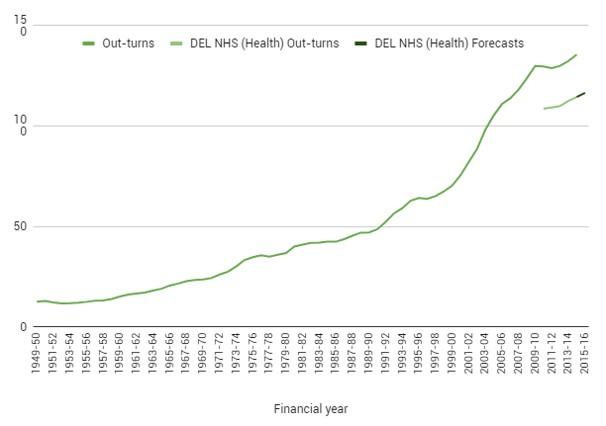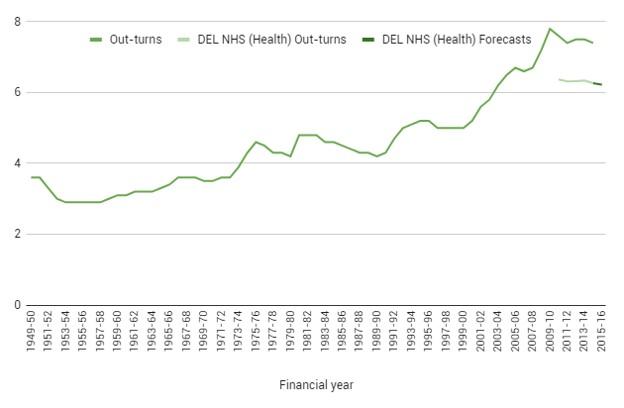Health spending has experienced significant growth since 1949–50, at an average annual real rate of 3.7% up to 2014–15. After uneven growth between the 1970s and the late 1990s, the last Labour government oversaw an acceleration of the increases in spending on the National Health Service, pushing up health spending to around 7% of national income prior to the recession. While other departments have experienced budget cuts as part of the coalition government’s programme of austerity, spending on health has been increased in real terms. This ‘protection’ nonetheless represents a tight funding environment for the NHS, not least as demographic pressure pushes up demand.
Over the last 60 years, spending on health (primarily via the NHS) has grown significantly – both as a share of public expenditure and as a share of national income. An increase in total health spending (both public and private) over this period is unsurprising, for at least three reasons: first, the proportion of elderly people in the population increased (and elderly people typically consume more, and more expensive, health care); second, there is a general propensity of societies to spend a higher share of their income on health as that income rises; and finally, advances in medicine mean we are now able to treat a wider range of ailments. These factors are likely to outweigh the countervailing pressure from technological improvements and the expiry of patents, which should reduce the cost of treatments over time.
Figure 1a shows the growth in real-terms health spending over time. This growth is strong compared with growth of total spending over the same period, although it has not been consistent over time. Health spending grew steadily from the early 1950s up to the early 1970s, both in real terms and as a share of national income (shown in Figure 1b). From the early 1970s until the late 1990s, however, it was more common to have large real increases in spending for one or two years in a row, interspersed with years of lower spending growth.
Figure 1a. Health spending in real terms (£ billion, 2015–16 prices), 1949–50 to 2015–16

Note: Assumes that prior to 1978–79, the NHS represented the same proportion of overall health spending as it did in 1978–79 (100.2%). 'DEL NHS (Health)' is the budget for the Department of Health (which is responsible for the NHS in England). Converted into real terms using the GDP deflator.
Source: Office of Health Economics for NHS spending prior to 1978; HM Treasury, various editions of Public Expenditure Statistical Analyses (PESA) thereafter.
Figure 1b. Health spending as a share of national income (%), 1949–50 to 2015–16

Note: Assumes that prior to 1978–79, the NHS represented the same proportion of overall health spending as it did in 1978–79 (100.2%). 'DEL NHS (Health)' is the budget for the Department of Health (which is responsible for the NHS in England).
Source: Office of Health Economics for NHS spending prior to 1978; HM Treasury, various editions of Public Expenditure Statistical Analyses (PESA) thereafter.
Under the Labour government from 1997–98, real growth in spending on health accelerated. This contributed to the longest period of sustained real spending growth seen in the history of the NHS. These substantial increases in health spending were determined in light of the recommendations of the Wanless Review, an independent review of the health service in the UK that was undertaken by Derek Wanless and completed in April 2002. The aim was to achieve a world-class health service: the Wanless Review said an average annual real increase in NHS spending of 4.2–5.1% over the 20 years between 2002–03 and 2022–23 would be required to deliver the ‘high quality health service’ envisaged.
In 2010–11 growth in health spending stalled, though in recent years it has picked up again. This period of relatively flat health spending is actually the result of relative protection for the NHS, as other departments have seen real-terms cuts to their budgets. However, it still implies a fall in health spending as a proportion of national income, as shown in Figure 1b. The new Conservative government has committed to increasing NHS spending by £8 billion in real terms by 2020–21. This IFS Green Budget chapter discusses the demand and cost pressures facing the NHS, why such funding increases have been called for, and why this parliament might still be a challenging time for the NHS.
Useful resources
- International comparisons of health spending, as well as public and private health spending over time, from the OECD health statistics database
- Chapter in the 2015 Green Budget looking into the recent history and future challenges for health spending
- Report from 2000 considering the challenges for the NHS